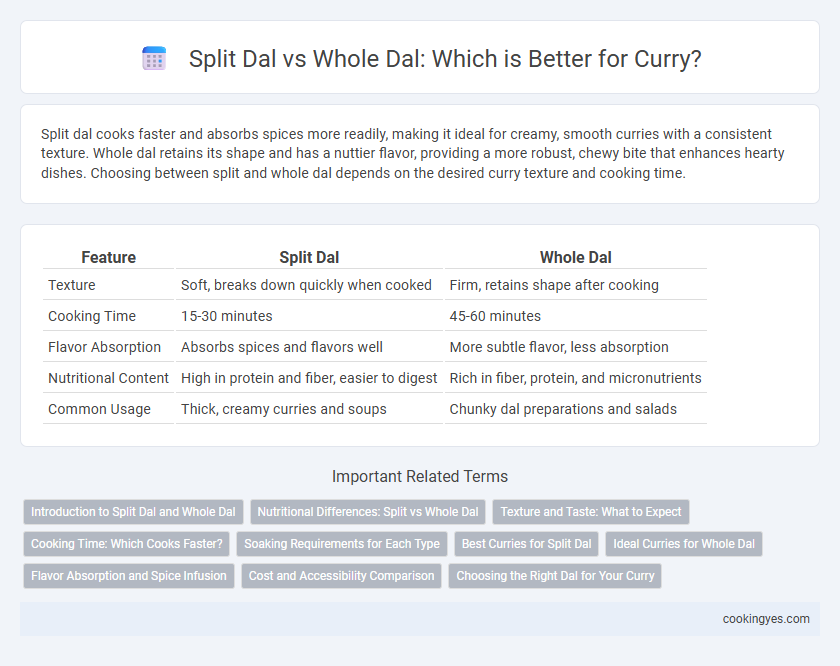Split dal cooks faster and absorbs spices more readily, making it ideal for creamy, smooth curries with a consistent texture. Whole dal retains its shape and has a nuttier flavor, providing a more robust, chewy bite that enhances hearty dishes. Choosing between split and whole dal depends on the desired curry texture and cooking time.
Table of Comparison
| Feature | Split Dal | Whole Dal |
|---|---|---|
| Texture | Soft, breaks down quickly when cooked | Firm, retains shape after cooking |
| Cooking Time | 15-30 minutes | 45-60 minutes |
| Flavor Absorption | Absorbs spices and flavors well | More subtle flavor, less absorption |
| Nutritional Content | High in protein and fiber, easier to digest | Rich in fiber, protein, and micronutrients |
| Common Usage | Thick, creamy curries and soups | Chunky dal preparations and salads |
Introduction to Split Dal and Whole Dal
Split dal refers to pulses that have been hulled and split into halves, removing the outer skin, which allows for quicker cooking and a softer texture often preferred in curries. Whole dal retains the outer skin and is unbroken, offering a firmer texture and a richer nutritional profile with higher fiber content, ideal for curries requiring a heartier bite. Choosing between split and whole dal depends on the desired cooking time and texture for the curry dish.
Nutritional Differences: Split vs Whole Dal
Split dal cooks faster than whole dal due to the removal of the outer husk, resulting in a softer texture ideal for curries. Whole dal retains more fiber, vitamins, and minerals like iron and magnesium, offering higher nutritional value and better digestive benefits. Split dal loses some nutrients in processing but remains rich in protein and easily digestible, making it a convenient yet nutritious choice for curry dishes.
Texture and Taste: What to Expect
Split dal offers a softer texture and quicker cooking time, making it ideal for creamy curries with a smooth consistency. Whole dal retains its shape and delivers a firmer bite, adding a hearty, distinct texture that complements robust spice blends. Expect split dal to produce a mellow, blended flavor while whole dal provides a nutty, earthy taste with more complexity in curry dishes.
Cooking Time: Which Cooks Faster?
Split dal cooks significantly faster than whole dal due to its reduced size and the removal of the outer husk, which allows heat and water to penetrate more quickly during cooking. Whole dal retains the husk and is denser, often requiring soaking and longer cooking times, sometimes twice as long as split dal. For curry preparation, opting for split dal saves time while still delivering a creamy texture and balanced flavor.
Soaking Requirements for Each Type
Split dal requires minimal soaking time, typically 15 to 30 minutes, to soften and cook evenly in curry preparations. Whole dal demands longer soaking periods of 4 to 8 hours to reduce cooking time and enhance texture, ensuring a creamy consistency in the final dish. Proper soaking of whole dal also aids in better digestion and nutrient absorption, critical for rich, hearty curries.
Best Curries for Split Dal
Split dal, commonly used in curries, offers faster cooking times and a smoother texture compared to whole dal, making it ideal for creamy, richly spiced dishes like dal tadka and dal makhani. The broken pieces absorb spices and flavors more efficiently, creating a harmonious balance in lentil-based curries such as chana dal and toor dal recipes. Split dal varieties like red lentils and yellow moong dal are highly favored for their ability to blend well with robust spices, enhancing the depth and aroma essential to authentic Indian curry preparations.
Ideal Curries for Whole Dal
Whole dal retains its husk, offering a nuttier flavor and firmer texture that holds shape well in slow-cooked curries like dal makhani and sambar. Its intact fiber content enhances digestion and provides a richer mouthfeel, making it ideal for hearty, thick curries requiring longer simmering. Whole dals such as urad, chana, and moong deliver superior depth and complexity in traditional Indian curry recipes compared to their split counterparts.
Flavor Absorption and Spice Infusion
Split dal offers enhanced flavor absorption and spice infusion compared to whole dal due to its exposed surface area, allowing spices and seasonings to penetrate more deeply during cooking. Whole dal retains a firmer texture but absorbs flavors more slowly, resulting in a milder, less intense curry profile. For rich, well-spiced curries, split dal is preferred as it integrates spices thoroughly, elevating the overall taste experience.
Cost and Accessibility Comparison
Split dal offers a more affordable and widely accessible option compared to whole dal, making it suitable for budget-conscious cooks and everyday meals. Whole dal tends to be more expensive due to less processing and longer cooking times but provides a richer texture and flavor. Availability varies by region, with split dal commonly found in most grocery stores, while whole dal may require visits to specialty or ethnic markets.
Choosing the Right Dal for Your Curry
Choosing the right dal for your curry depends on texture and cooking time; split dal cooks faster and absorbs spices more readily, making it ideal for creamy, smooth curries. Whole dal retains its shape and offers a nuttier flavor and firmer texture, perfect for traditional, hearty dishes that require longer cooking. Understanding these differences helps achieve the desired consistency and flavor profile in your curry recipe.
Split Dal vs Whole Dal for Curry Infographic

 cookingyes.com
cookingyes.com